*NURSING > QUESTIONS & ANSWERS > MN 551 Unit 9 Quiz Answers & Rationale, Complete solutions, Kaplan University, Davenport. GRADED A+ (All)
MN 551 Unit 9 Quiz Answers & Rationale, Complete solutions, Kaplan University, Davenport. GRADED A+
Document Content and Description Below
MN 551 Unit 9 Quiz Answers & Rationale. Question 1. A clinician is conducting an assessment of a male patient suspected of having a disorder of motor function. Which of the following assessment findin... gs would suggest a possible upper motor neuron (UMN) lesion? (Points : 0.4) The patient has decreased deep tendon reflexes. The patient displays increased muscle tone. The patient's muscles appear atrophied. The patient displays weakness in the distal portions of his limbs. Question 2. A 51-year-old has been admitted to a rehabilitation center after hospital treatment for an ischemic stroke. Which of the following aspects of the patient's history would not be considered to have contributed to his stroke? (Points : 0.4) He was diagnosed with type 2 diabetes eight years ago Elevated cholesterol Blood pressure that is normally 120/80 The patient is an African American Male History of sickle cell anemia Question 3. Following a spinal cord injury suffered in a motor vehicle accident, a 22-year-old male has lost fine motor function of his finger and thumb, but is still able to perform gross motor movements of his hand and arm. Which of the following components of his white matter has most likely been damaged? (Points : 0.4) The inner layer (archilayer) The middle layer (paleolayer) The outer layer (neolayer) The reticular formation Question 4. A 44-year-old female has been diagnosed with major depression. Which of the following neuroimaging findings is most congruent with the woman's diagnosis? (Points : 0.4) Decreased brain activity in the pons and brain stem Reduced activity and gray matter volume in the prefrontal cortex Atrophy and decreased blood flow in the amygdala Enlargement of the lateral and third ventricles and reduction in frontal and temporal volumes Question 5. Which of the following phenomena constitutes a component of axonal transport? (Points : 0.4) Anterograde and retrograde axonal transport allow for the communication of nerve impulses between a neuron and the central nervous system (CNS). Materials can be transported to the nerve terminal by either fast or slow components. The unidirectional nature of the axonal transport system protects the CNS against potential pathogens. Axonal transport facilitates the movement of electrical impulses but precludes the transport of molecular materials. Question 6. A patient in the intensive care unit who has a brain tumor has experienced a sharp decline. The care team suspects that water and protein have crossed the blood–brain barrier and been transferred from the vascular space into the patient's interstitial space. Which of the following diagnoses best captures this pathophysiology? (Points : 0.4) Focal hypoxia Cytotoxic edema Hydrocephalus Vasogenic edema . Question 7. A nurse practitioner is providing care for a 68-year-old female whose anxiety disorder is significantly decreasing her quality of life. Which of the following pharmacologic therapies is most likely to benefit the woman? (Points : 0.4) A drug that influences gamma-aminobutyric acid (GABA) levels A selective serotonin reuptake inhibitor (SSRI) An antipsychotic medication that blocks dopamine receptors An epinephrine and norepinephrine supplement Question 8. A 60-year-old male patient with a long history of back pain has had little success with a variety of analgesic regimens that his nurse practitioner has prescribed. He has recently been diagnosed formally with a chronic pain disorder. Which of the following teaching points about chronic pain would his nurse practitioner most likely emphasize to the patient? (Points : 0.4) “If your pain comes and goes, then we won't characterize it as chronic, and it will require different treatment.” “You need to remind yourself that this is a purely physical phenomenon that requires physical treatment.” “Our challenge is to bring you relief but still treat the underlying back problem that your body is telling you about.” “These pain signals your body is sending likely serve no real, useful, or protective function.” Question 9. A 22-year-old female college student is shocked to receive a diagnosis of myasthenia gravis. What are the etiology and most likely treatment for her health problem? (Points : 0.4) Autoimmune destruction of skeletal muscle cells; treatment with intensive physical therapy and anabolic steroids A shortage or decline of acetylcholine receptors; treatment with corticosteroids and intravenous immunoglobulins Cerebellar lesions; surgical and immunosuppressive treatment Excess acetylcholinesterase production; treatment with thymectomy Question 10. A student is feeling inside her backpack to find her mobile phone, which has fallen to the bottom, and there are a number of items in the bag in addition to the phone. Which of the following components of somatosensory conduction is most likely to provide the detailed sensory information that will help her distinguish her phone from other items? (Points : 0.4) The primary dorsal root ganglion neuron, the dorsal column neuron, and the thalamic neuron A slow-conducting pathway that projects into the intralaminar nuclei of the thalamus The opposite anterolateral pathway that travels to the reticular activating system A bilateral, multisynaptic, slow-conducting tract Question 11. A patient on an acute medicine unit of a hospital, with a diagnosis of small bowel obstruction, is complaining of intense, diffuse pain in her abdomen. Which of the following physiologic phenomena is most likely contributing to her complaint? (Points : 0.4) Nociceptive afferents are conducting the sensation of pain along the cranial and spinal nerve pathways of the ANS. First-order neurons are inappropriately signaling pain to the dorsal root ganglion. The patient is experiencing neuropathic pain. The patient's C fibers are conducting pain in the absence of damaged Ad fibers. Question 12. Which of the following factors is most responsible for the fact that prefrontal lobotomy is no longer a common treatment for mental illness? (Points : 0.4) Individuals treated by lobotomy have difficulty interpreting somatic, visual, and auditory information. Lobotomy inhibits the individual's ability to add perception and meaning to sensory information. Severing connections between the brain and its prefrontal areas inhibits problem solving and results in a loss of ambition. Loss of communication to and from the prefrontal cortex changes, but ultimately exacerbates, symptoms of mental illness. Question 13. The unique clinical presentation of a three-month-old infant in the emergency department leads the care team to suspect botulism. Which of the following assessment questions posed to the parents is likely to be most useful in the differential diagnosis? (Points : 0.4) “Have you ever given your child any honey or honey-containing products?” “Is there any family history of neuromuscular diseases?” “Has your baby ever been directly exposed to any chemical cleaning products?” “Is there any mold in your home that you know of?” Question 14. A 17-year-old female is suspected of having narcolepsy. Which of the following aspects of her medical history and sleep analysis would contribute to a confirmation of the diagnosis? (Points : 0.4) She repeatedly moves her large toe, ankle, and knee during sleep. She complains of a powerful urge to move her legs when in bed at night. She has frequently awakened unable to move or speak. She believes that she experiences auditory hallucinations when she awakens. Her sleep latency is normally around 1 hour. Question 15. A nurse practitioner is assessing a 7-year-old boy who has been brought to the clinic by his mother, who is concerned about her son's increasingly frequent, severe headaches. Which of the nurse's following questions is least likely to yield data that will allow for a confirmation or ruling out of migraines as the cause of his problem? (Points : 0.4) “Does your son have a family history of migraines?” “When your son has a headache, does he ever have nausea and vomiting as well?” “Does your son have any food allergies that have been identified?” “Is your son generally pain free during the intervals between headaches?” Question 16. Following a motor vehicle accident three months prior, a 20-year-old female who has been in a coma since her accident has now had her condition declared a persistent vegetative state. How can her care providers most accurately explain an aspect of her situation to her parents? (Points : 0.4) “Your daughter has lost all her cognitive functions as well as all her basic reflexes.” “Though she still goes through a cycle of sleeping and waking, her condition is unlikely to change.” “If you or the care team notice any spontaneous eye opening, then we will change our treatment plan.” “Your daughter's condition is an unfortunate combination of total loss of consciousness with continuation of all other normal brain functions.” Question 17. A male newborn infant has been diagnosed with spina bifida occulta. Which of the following pathophysiologic processes has most likely contributed to the infant's health problem? [Show More]
Last updated: 2 years ago
Preview 1 out of 9 pages

Buy this document to get the full access instantly
Instant Download Access after purchase
Buy NowInstant download
We Accept:

Reviews( 0 )
$12.00
Can't find what you want? Try our AI powered Search
Document information
Connected school, study & course
About the document
Uploaded On
Sep 23, 2021
Number of pages
9
Written in
Additional information
This document has been written for:
Uploaded
Sep 23, 2021
Downloads
0
Views
112


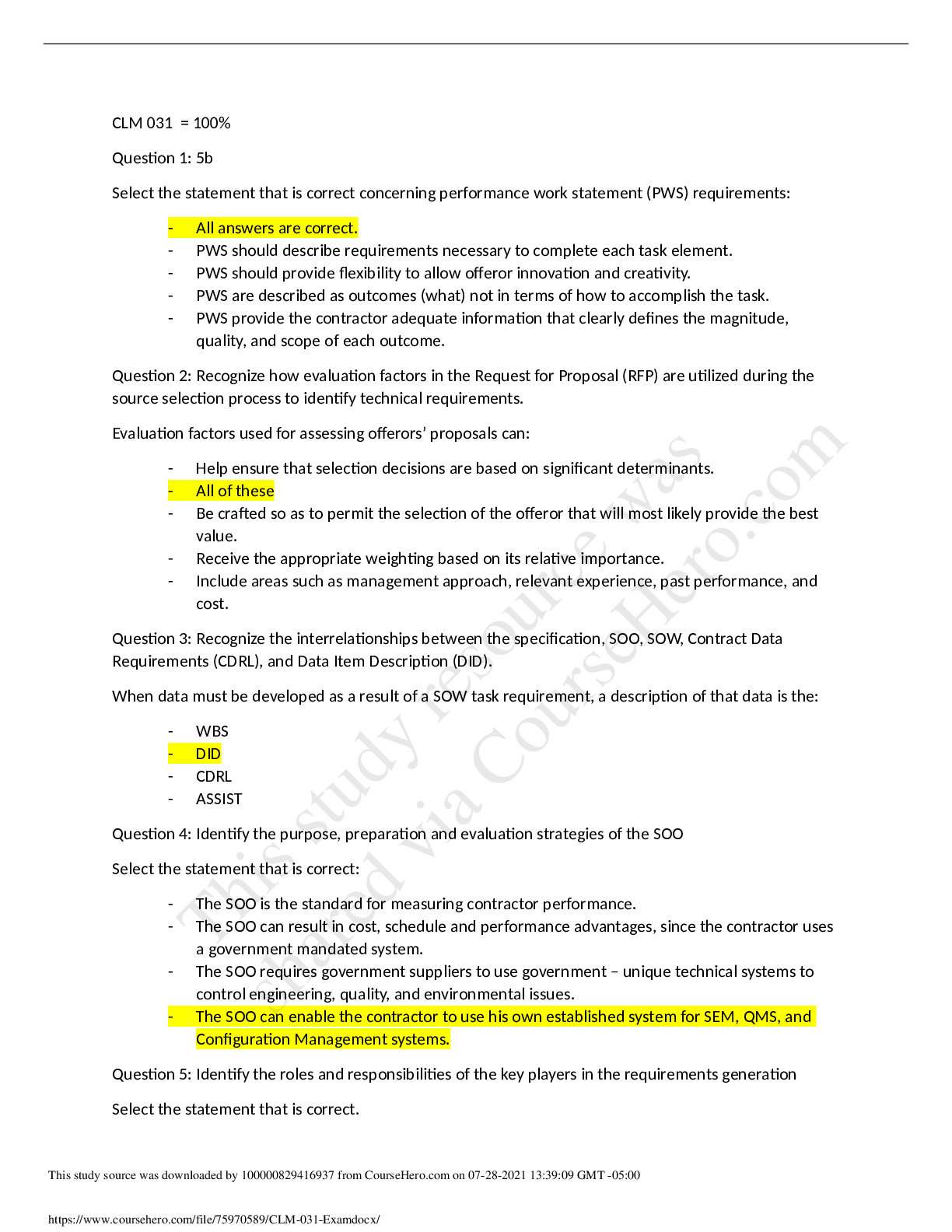

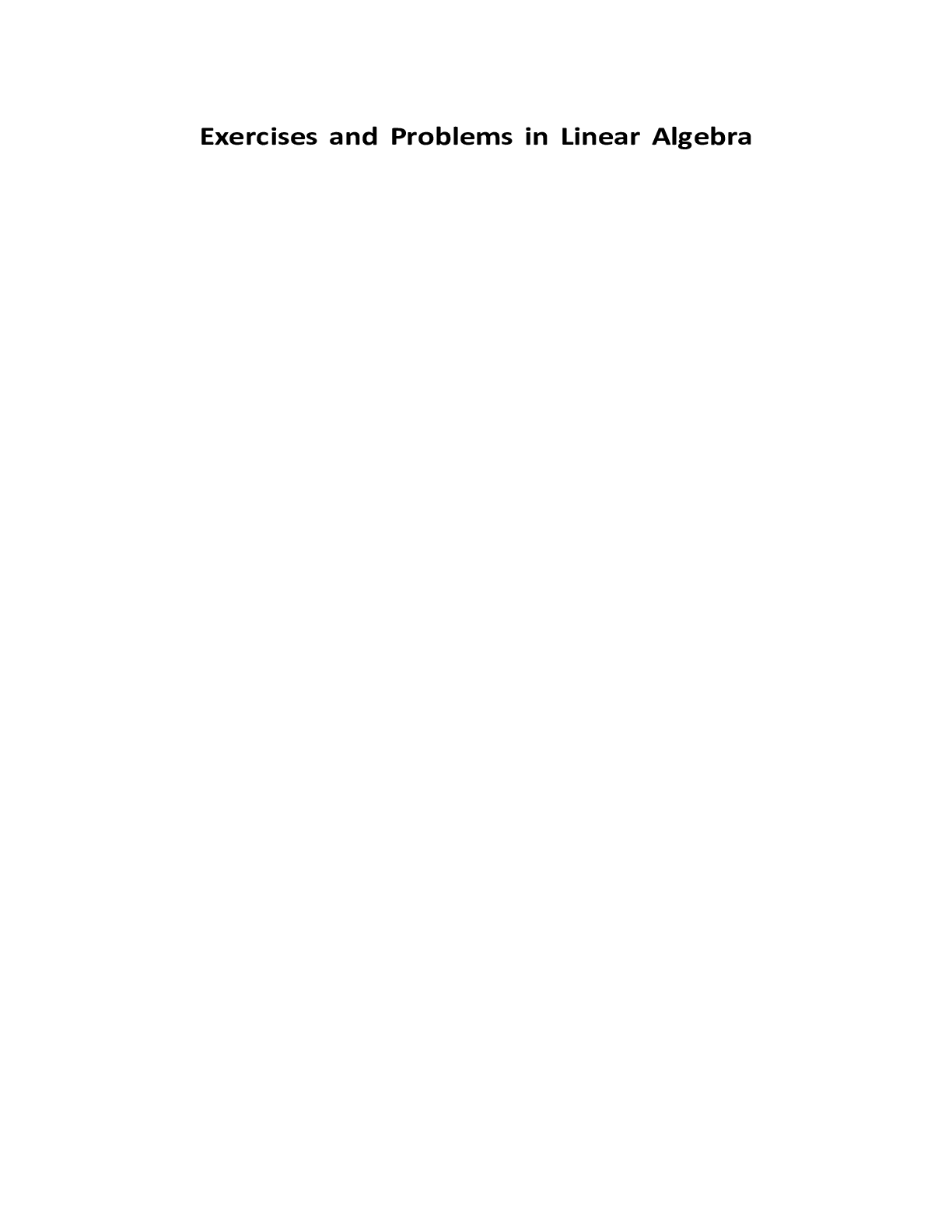

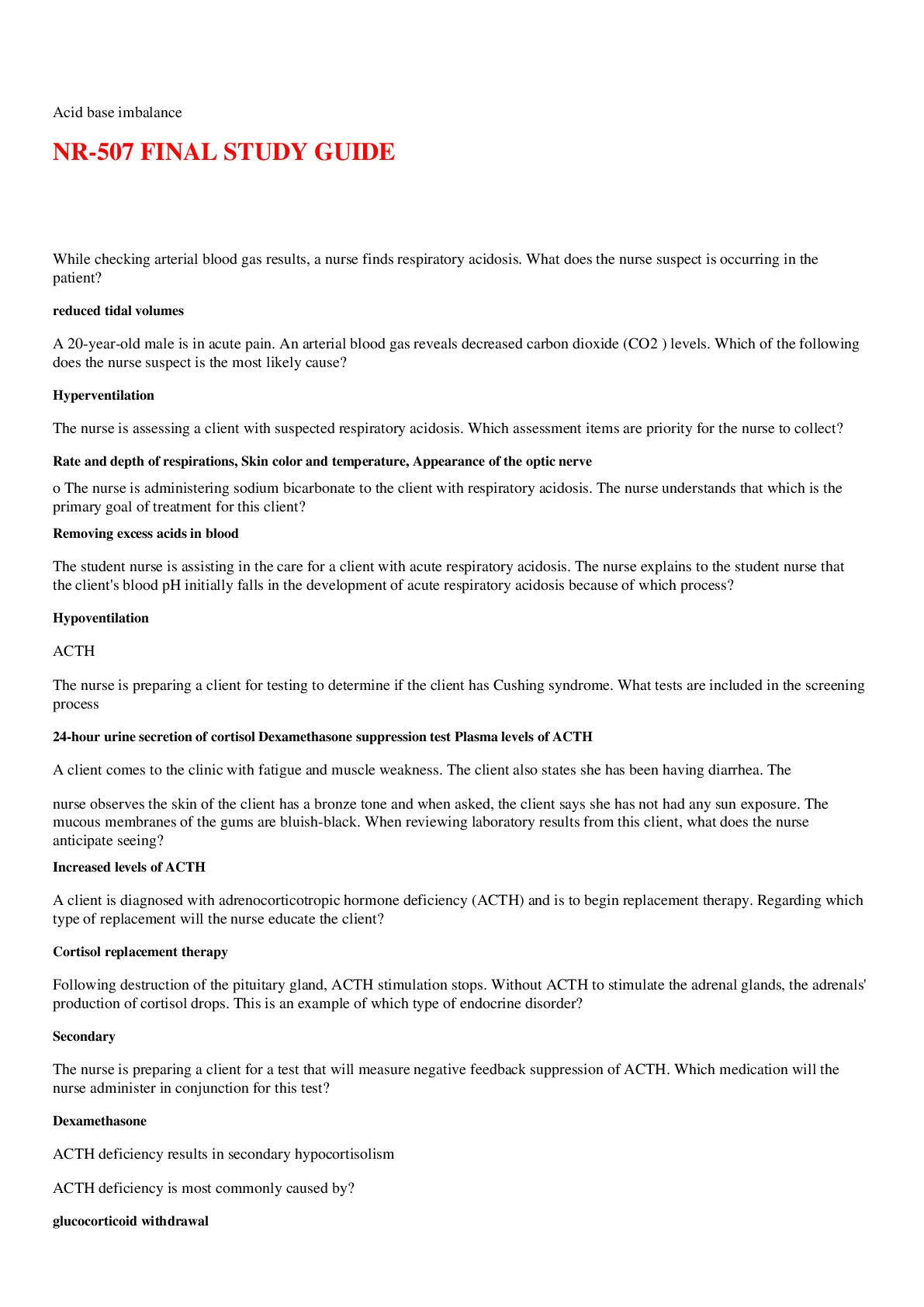

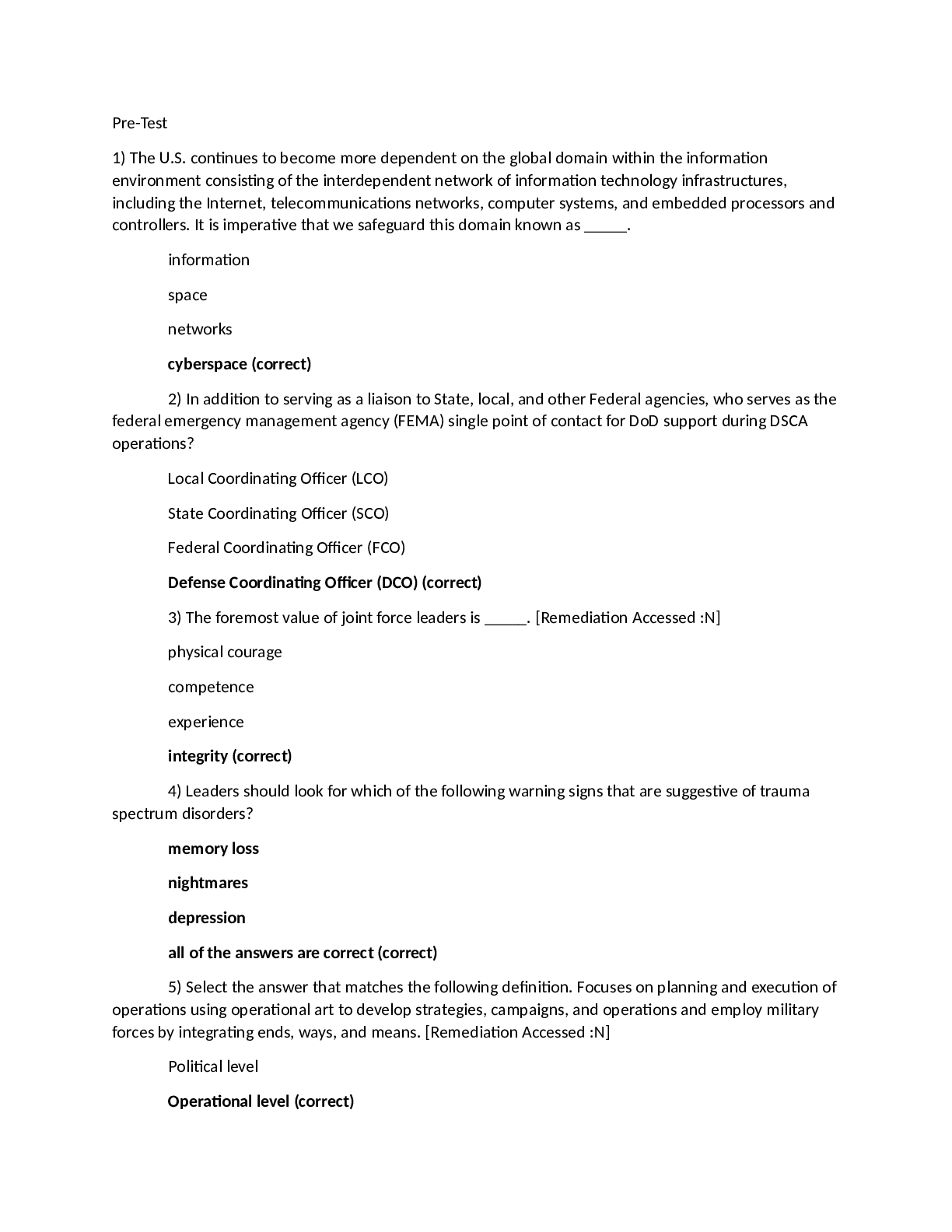
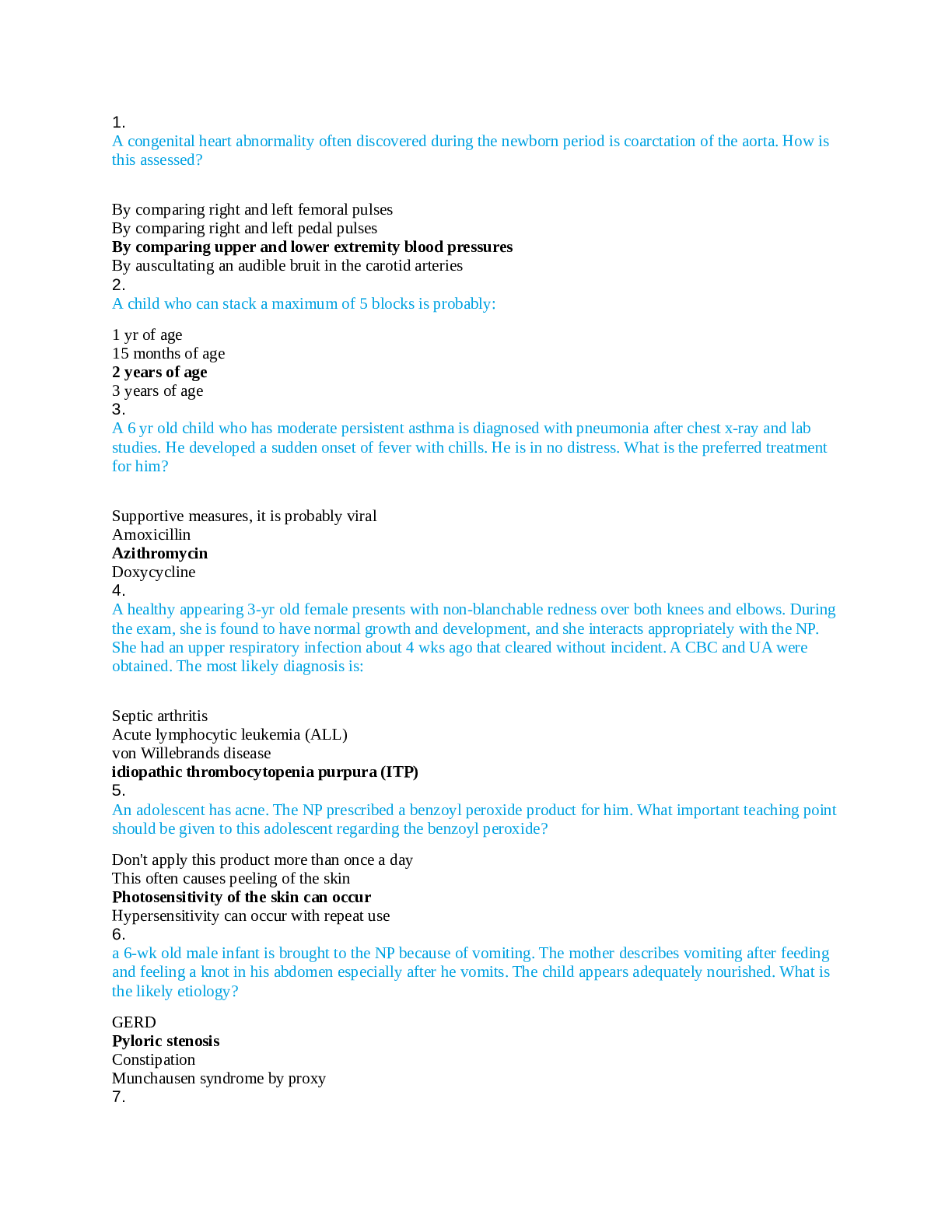
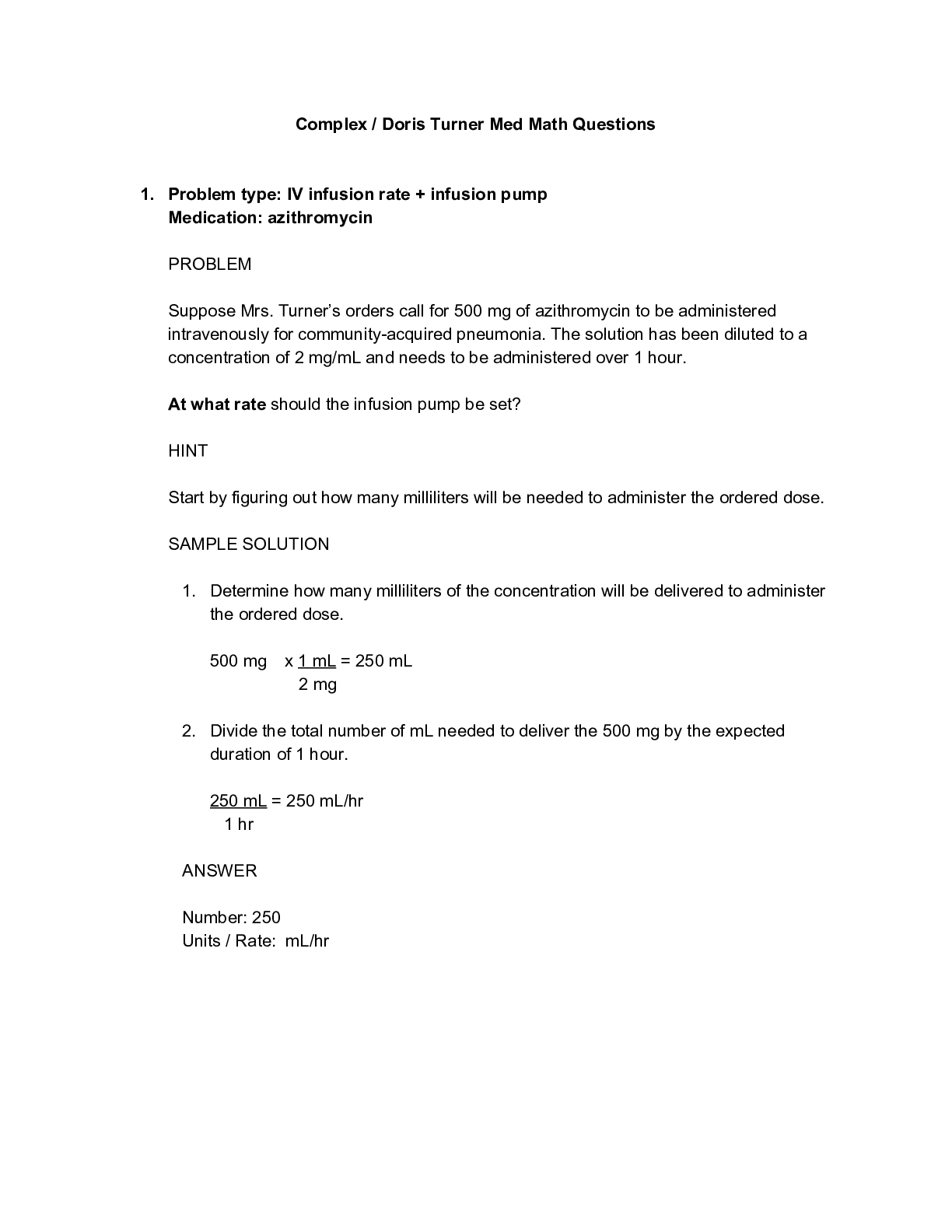








 2021.png)


